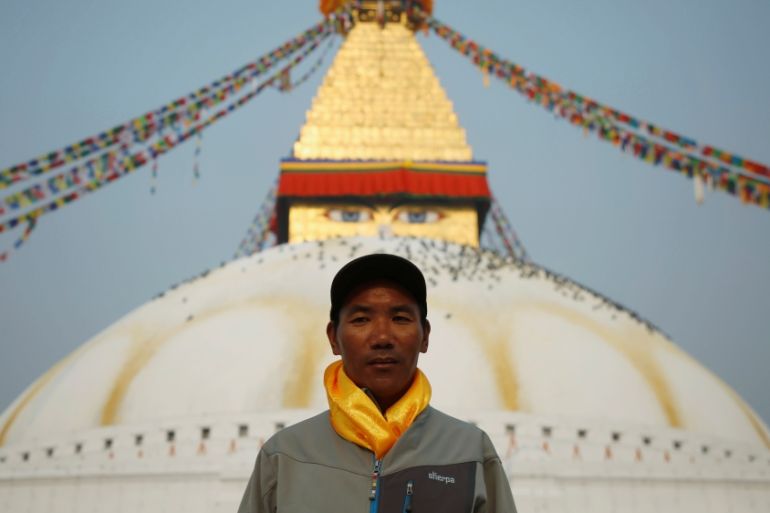Sherpa to climb Mount Everest for a record 22nd time
“I am not extremely happy, excited or very sad no matter how many times I climb.”

A Nepali Sherpa is hoping to summit Mount Everest for a record-breaking 22nd time next month, during the busy climbing season that each year sees hundreds of climbers reach the top of the world.
But to Kami Rita Sherpa, who has worked as a guide on Everest for over two decades, climbing to 8,848 metres is a job, not a record-shattering feat.
Keep reading
list of 4 itemsRecord Mount Everest season in Nepal also one of its deadliest
Sherpa saves Malaysian climber in Everest ‘death zone’ rescue
Everest continues to attract climbers 70 years after first summit
“I did not start climbing to set a world record. But in the course of my work in the guiding industry, this is going to be my 22nd ascent. It wasn’t for any competition,” Kami Rita told the AFP news agency in Kathmandu before setting out for the mountain.
When 48-year-old Kami Rita first summited Everest in 1994, he was one of just 49 climbers to reach the peak.
“I am not extremely happy, excited or very sad no matter how many times I climb. There are many Sherpas who have held world records, I am just starting.”
“My life is just normal,” he added as he headed off for the top of the world.
Cost of inexperience
Kami Rita, who has worked for US-based Alpine Ascents for much of his career, said the key differences between the operators is how well they train – and pay – their Sherpa guides.
“Some foreigners (climbers) seek only cheap options which means they will get low-quality, cheap Sherpa. If they pay high price, they will get a high-price (quality) Sherpa,” he said.
Most paying climbers try to reach the summit with the help of a dedicated Sherpa guide, but the number of experienced Sherpa has not been able to keep pace with demand, warned Kami Rita.
“Earlier, we had to knock on the companies’ doors for jobs. Now the tables have turned, the companies have to please the Sherpas to work with them. Why? Because there is shortage,” he said.
Last year, a record number of rescues were made from the mountain, which observers point as a sign of the growing cost of inexperience – among both paying climbers and Sherpa guides – on the mountain.
The Nepali and Chinese authorities, who monitor all climbs on the southern and northern faces of the mountain respectively, are yet to release the number of climbing permits issued for this year.
But the season – which marks the 65th anniversary of the first summit of Everest by Edmund Hillary and Tenzing Norgay – is expected to be as busy as the last.
Lucrative industry
Over the last two decades, the booming number of climbers on Everest has created a lucrative mountaineering industry in both China and Nepal, which share the peak.
Last year, 634 people made it to the top.
In Nepal – home to eight of the world’s highest peaks – the climbers provide vital income: last year the impoverished country netted over $4m in permit fees on Everest alone.
Each year, hundreds of climbers begin gathering at the foot of the world’s highest peak from early April, turning the base camp into a bustling nylon tent city.
They spend nearly two months on the mountain to acclimatise to the harsh high altitude environment before attempting to reach the summit in May.
Spring is the busiest time of year on the mountain as the winds and temperatures are more forgiving than at other times of the year. But nonetheless, each spring Everest claims a few lives: last year seven climbers died on the mountain.
The rapid growth in the climbing industry has also led to fears of deadly overcrowding on Everest, with the mountain opening up to more people as competition between expedition organisers has seen the costs plummet.
The cheapest operators charge clients around $20,000 to take them to the top of the world, a quarter of the amount demanded by the most expensive.
That discrepancy has caused tension on the mountain, with the mostly foreign-run companies accusing the largely Nepali-run cheaper ones of skimping on basic safety to keep costs low while also accepting clients who lack high-altitude climbing experience.